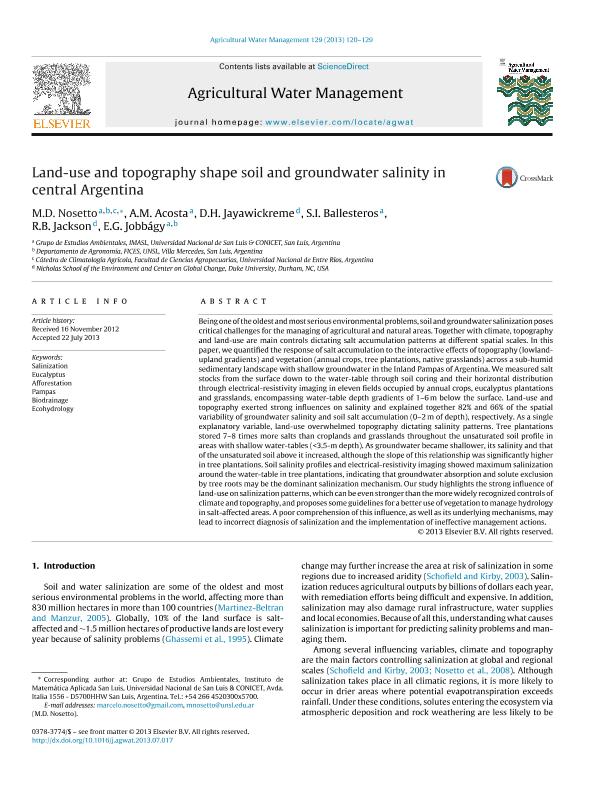Mostrar el registro sencillo del ítem
dc.contributor.author
Nosetto, Marcelo Daniel

dc.contributor.author
Acosta, A. M.
dc.contributor.author
Jayawickreme, D. H.
dc.contributor.author
Ballesteros, Silvina

dc.contributor.author
Jackson, R. B.
dc.contributor.author
Jobbagy Gampel, Esteban Gabriel

dc.date.available
2016-05-23T20:33:12Z
dc.date.issued
2013-01
dc.identifier.citation
Nosetto, Marcelo Daniel; Acosta, A. M.; Jayawickreme, D. H.; Ballesteros, Silvina; Jackson, R. B.; et al.; Land-use and topography shape soil and groundwater salinity in central Argentina; Elsevier; Agricultural Water Management; 129; 1-2013; 120-129
dc.identifier.issn
0378-3774
dc.identifier.uri
http://hdl.handle.net/11336/5800
dc.description.abstract
Being one of the oldest and most serious environmental problems, soil and groundwater salinization poses critical challenges for the managing of agricultural and natural areas. Together with climate, topography and land-use are main controls dictating salt accumulation patterns at different spatial scales. In this paper, we quantified the response of salt accumulation to the interactive effects of topography (lowland-upland gradients) and vegetation (annual crops, tree plantations, native grasslands) across a sub-humid sedimentary landscape with shallow groundwater in the Inland Pampas of Argentina. We measured salt stocks from the surface down to the water table through soil coring and their horizontal distribution through electrical-resistivity imaging in eleven fields occupied by annual crops, eucalyptus plantations and grasslands encompassing groundwater depth gradients of 1 to 6 m below the surface. Land-use and topography exerted strong influences on salinity and explained together 82% and 66% of the spatial variability of groundwater salinity and soil salt accumulation (0-2 m of depth), respectively. As a single explanatory variable, land-use overwhelmed topography dictating salinity patterns. Tree plantations stored 7 to 8 times more salts than croplands and grasslands throughout the unsaturated soil profile in areas with shallow water-tables (<3.5-m depth). As groundwater became shallower, its salinity and that of the unsaturated soil above it increased, although the slope of this relationship was significantly higher in tree plantations. Soil salinity profiles and electrical-resistivity imaging showed maximum salinization around the water-table in tree plantations, indicating that groundwater absorption and solute exclusion by tree roots may be the dominant salinization mechanism. Our study highlights the strong influence of land-use on salinization patterns, which can be even stronger than the more widely recognized controls of climate and topography, and proposes some guidelines for a better use of vegetation to manage hydrology in salt-affected areas. A poor comprehension of this influence, as well as its underlying mechanisms, may lead to incorrect diagnosis of salinization and the implementation of ineffective management actions.
dc.format
application/pdf
dc.language.iso
eng
dc.publisher
Elsevier

dc.rights
info:eu-repo/semantics/openAccess
dc.rights.uri
https://creativecommons.org/licenses/by-nc-nd/2.5/ar/
dc.subject
Salinizacion
dc.subject
Cambio en El Uso De La Tierra
dc.subject
Forestacion
dc.subject
Cultivo
dc.subject.classification
Agricultura

dc.subject.classification
Agricultura, Silvicultura y Pesca

dc.subject.classification
CIENCIAS AGRÍCOLAS

dc.title
Land-use and topography shape soil and groundwater salinity in central Argentina
dc.type
info:eu-repo/semantics/article
dc.type
info:ar-repo/semantics/artículo
dc.type
info:eu-repo/semantics/publishedVersion
dc.date.updated
2016-05-16T20:07:33Z
dc.journal.volume
129
dc.journal.pagination
120-129
dc.journal.pais
Países Bajos

dc.journal.ciudad
Amsterdam
dc.description.fil
Fil: Nosetto, Marcelo Daniel. Consejo Nacional de Investigaciones Científicas y Técnicas. Centro Científico Tecnológico San Luis. Instituto de Matemática Aplicada de San Luis; Argentina. Universidad Nacional de San Luis; Argentina. Universidad Nacional de Entre Ríos. Facultad de Ciencias Agropecuarias; Argentina
dc.description.fil
Fil: Acosta, A. M.. Consejo Nacional de Investigaciones Científicas y Técnicas. Centro Científico Tecnológico San Luis. Instituto de Matemática Aplicada de San Luis; Argentina
dc.description.fil
Fil: Jayawickreme, D. H.. University Of Duke. Nicholas School Of Environment; Estados Unidos
dc.description.fil
Fil: Ballesteros, Silvina. Consejo Nacional de Investigaciones Científicas y Técnicas. Centro Científico Tecnológico San Luis. Instituto de Matemática Aplicada de San Luis; Argentina
dc.description.fil
Fil: Jackson, R. B.. University Of Duke. Nicholas School Of Environment; Estados Unidos
dc.description.fil
Fil: Jobbagy Gampel, Esteban Gabriel. Consejo Nacional de Investigaciones Científicas y Técnicas. Centro Científico Tecnológico San Luis. Instituto de Matemática Aplicada de San Luis; Argentina. Universidad Nacional de San Luis; Argentina
dc.journal.title
Agricultural Water Management

dc.relation.alternativeid
info:eu-repo/semantics/altIdentifier/doi/http://dx.doi.org/10.1016/j.agwat.2013.07.017
dc.relation.alternativeid
info:eu-repo/semantics/altIdentifier/doi/10.1016/j.agwat.2013.07.017
dc.relation.alternativeid
info:eu-repo/semantics/altIdentifier/url/http://www.sciencedirect.com/science/article/pii/S0378377413001984
Archivos asociados
